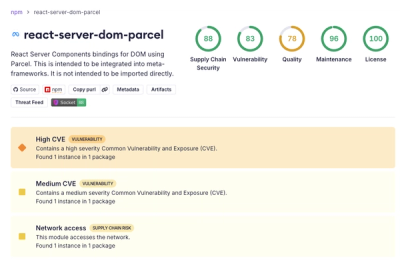arrow-js-ffi
Interpret Arrow memory across the WebAssembly boundary without serialization.
Why?
Arrow is a high-performance memory layout for analytical programs. Since Arrow's memory layout is defined to be the same in every implementation, programs that use Arrow in WebAssembly are using the same exact layout that Arrow JS implements! This means we can use plain ArrayBuffers to move highly structured data back and forth to WebAssembly memory, entirely avoiding serialization.
I wrote an interactive blog post that goes into more detail on why this is useful and how this library implements Arrow's C Data Interface in JavaScript.
Usage
This package exports two functions, parseField for parsing the ArrowSchema struct into an arrow.Field and parseVector for parsing the ArrowArray struct into an arrow.Vector.
parseField
Parse an ArrowSchema C FFI struct into an arrow.Field instance. The Field is necessary for later using parseVector below.
buffer (ArrayBuffer): The WebAssembly.Memory instance to read from.ptr (number): The numeric pointer in buffer where the C struct is located.
const WASM_MEMORY: WebAssembly.Memory = ...
const field = parseField(WASM_MEMORY.buffer, fieldPtr);
parseSchema
Parse an ArrowSchema C FFI struct into an arrow.Schema instance. Note that the underlying field must be a Struct type. In essence a Struct field is used to mimic a Schema while only being one field.
buffer (ArrayBuffer): The WebAssembly.Memory instance to read from.ptr (number): The numeric pointer in buffer where the C struct is located.
const WASM_MEMORY: WebAssembly.Memory = ...
const schema = parseSchema(WASM_MEMORY.buffer, fieldPtr);
parseData
Parse an ArrowArray C FFI struct into an arrow.Data instance. Multiple Data instances can be joined to make an arrow.Vector.
buffer (ArrayBuffer): The WebAssembly.Memory instance to read from.ptr (number): The numeric pointer in buffer where the C struct is located.dataType (arrow.DataType): The type of the vector to parse. This is retrieved from field.type on the result of parseField.copy (boolean, default: true): If true, will copy data across the Wasm boundary, allowing you to delete the copy on the Wasm side. If false, the resulting arrow.Data objects will be views on Wasm memory. This requires careful usage as the arrays will become invalid if the memory region in Wasm changes.
Example
const WASM_MEMORY: WebAssembly.Memory = ...
const copiedData = parseData(WASM_MEMORY.buffer, arrayPtr, field.type);
const viewedData = parseData(WASM_MEMORY.buffer, arrayPtr, field.type, false);
parseVector
Parse an ArrowArray C FFI struct into an arrow.Vector instance. Multiple Vector instances can be joined to make an arrow.Table.
buffer (ArrayBuffer): The WebAssembly.Memory instance to read from.ptr (number): The numeric pointer in buffer where the C struct is located.dataType (arrow.DataType): The type of the vector to parse. This is retrieved from field.type on the result of parseField.copy (boolean, default: true): If true, will copy data across the Wasm boundary, allowing you to delete the copy on the Wasm side. If false, the resulting arrow.Vector objects will be views on Wasm memory. This requires careful usage as the arrays will become invalid if the memory region in Wasm changes.
Example
const WASM_MEMORY: WebAssembly.Memory = ...
const copiedVector = parseVector(WASM_MEMORY.buffer, arrayPtr, field.type);
const viewedVector = parseVector(WASM_MEMORY.buffer, arrayPtr, field.type, false);
parseRecordBatch
Parse an ArrowArray C FFI struct plus an ArrowSchema C FFI struct into an arrow.RecordBatch instance. Note that the underlying array and field must be a Struct type. In essence a Struct array is used to mimic a RecordBatch while only being one array.
buffer (ArrayBuffer): The WebAssembly.Memory instance to read from.arrayPtr (number): The numeric pointer in buffer where the array C struct is located.schemaPtr (number): The numeric pointer in buffer where the field C struct is located.copy (boolean, default: true): If true, will copy data across the Wasm boundary, allowing you to delete the copy on the Wasm side. If false, the resulting arrow.Vector objects will be views on Wasm memory. This requires careful usage as the arrays will become invalid if the memory region in Wasm changes.
Example
const WASM_MEMORY: WebAssembly.Memory = ...
const copiedRecordBatch = parseRecordBatch(
WASM_MEMORY.buffer,
arrayPtr,
fieldPtr
);
const viewedRecordBatch = parseRecordBatch(
WASM_MEMORY.buffer,
arrayPtr,
fieldPtr,
false
);
parseTable
Parse an Arrow Table object from WebAssembly memory to an Arrow JS Table.
This expects an array of ArrowArray C FFI structs plus an ArrowSchema C FFI struct. Note that the underlying array and field pointers must be a Struct type. In essence a Struct array is used to mimic each RecordBatch while only being one array.
buffer (ArrayBuffer): The WebAssembly.Memory instance to read from.arrayPtrs (number[]): An array of numeric pointers describing the location in buffer where the array C struct is located that represents each record batch.schemaPtr (number): The numeric pointer in buffer where the field C struct is located.copy (boolean, default: true): If true, will copy data across the Wasm boundary, allowing you to delete the copy on the Wasm side. If false, the resulting arrow.Vector objects will be views on Wasm memory. This requires careful usage as the arrays will become invalid if the memory region in Wasm changes.
Example
const WASM_MEMORY: WebAssembly.Memory = ...
const table = parseTable(
WASM_MEMORY.buffer,
arrayPtrs,
schemaPtr,
true
);
Memory Management
TL;dr: As of version 0.4, arrow-js-ffi does not release any WebAssembly resources. You must free Arrow resources when you're done with them to avoid memory leaks. This library does not currently provide helpers to deallocate that memory; instead look for free methods exposed by Emscripten or wasm-bindgen.
Memory management between WebAssembly's own memory and JavaScript memory can be tricky. The Arrow C Data Interface includes prescriptions for memory management but those recommendations are designed for situations where two programs share the same memory space. Applying it to WebAssembly-JavaScript interop is imperfect because WebAssembly memory is sandboxed in a separate memory space.
The C Data Interface instructs consumers to call the release callback, which deallocates the referenced memory. However in our case, we can't call the release callback in all situations because the lifetime of views on the referenced Arrow data would outlive the lifetime of the data. Even when a user passes copy=true, where the data is copied into JS memory, it's still uncertain whether to release the underlying resources because the user might want to still do something with their Wasm table data.
A future release of arrow-js-ffi may include standalone functions to release Arrow data, which users can call manually once they know they're done with the data. But even in this case, freeing the underlying array will not free any wrapper structs allocated by Emscripten or wasm-bindgen. If the free method on those structs is called later, it would lead to a double-free.
If you have thoughts on memory management, open an issue!
Type Support
Most of the unsupported types should be pretty straightforward to implement; they just need some testing.
Primitive Types
Binary & String
Decimal
Temporal Types
Nested Types
Extension Types
TODO:
- Call the release callback on the C structs. This requires figuring out how to call C function pointers from JS.



